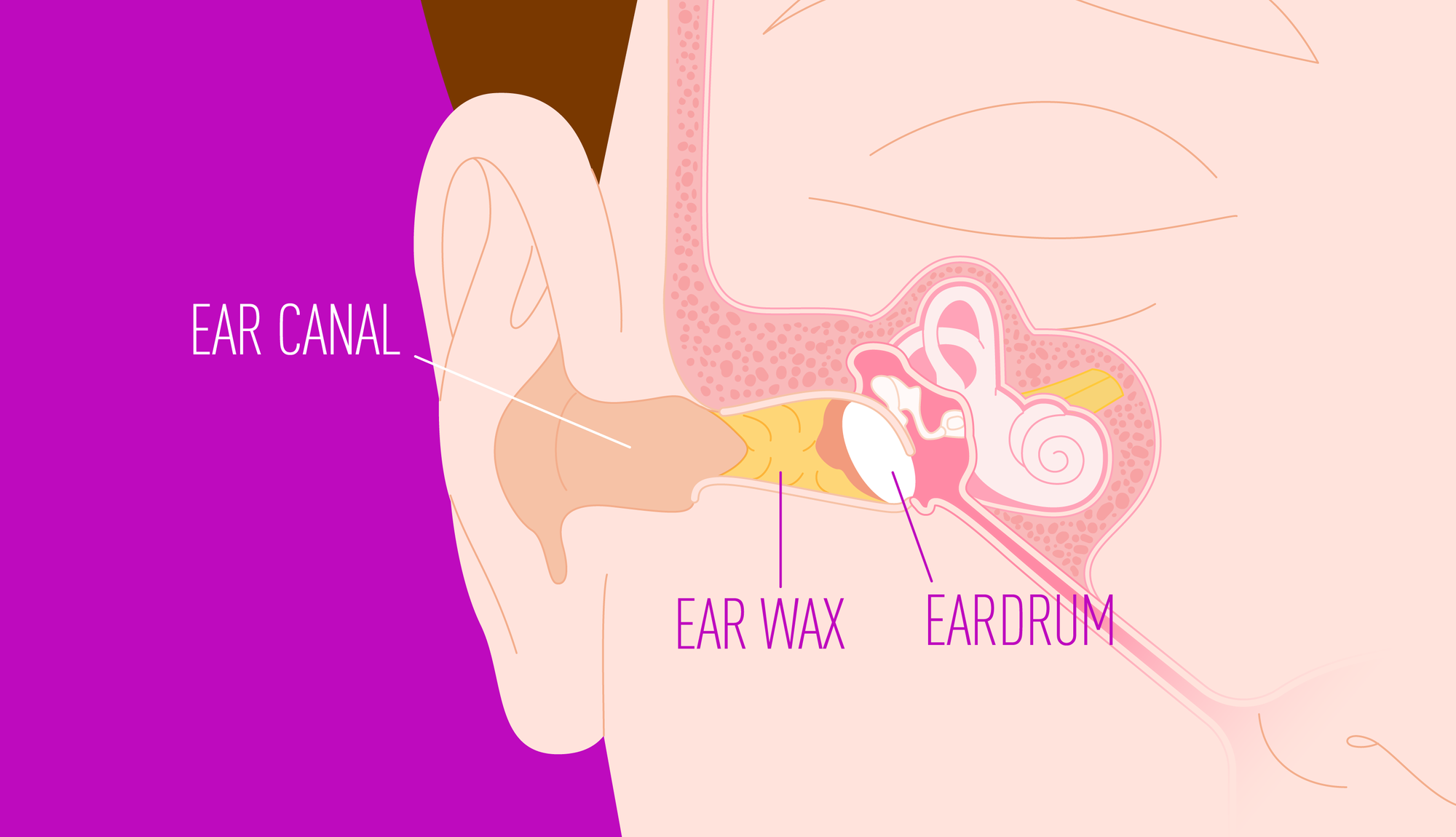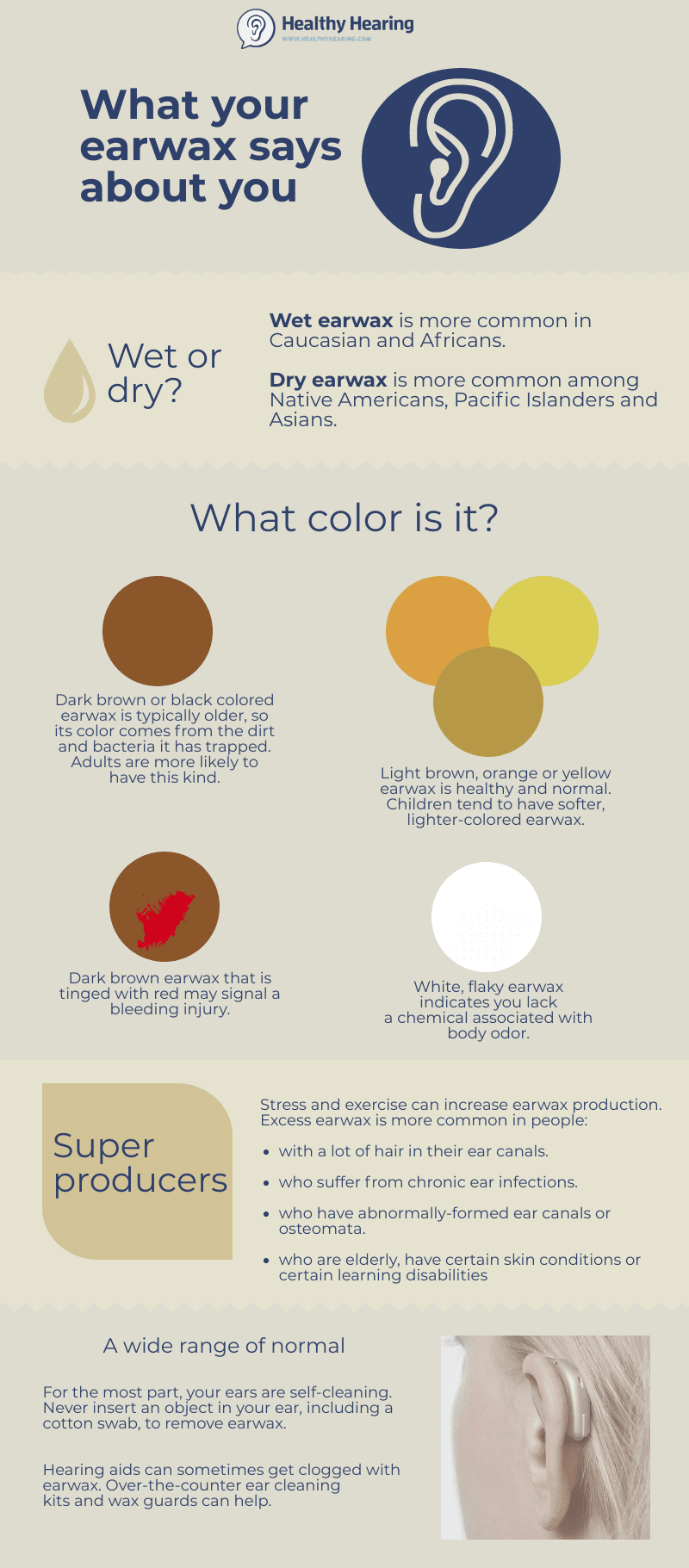Discover some wonderfully disgusting facts about wet and dry earwax. Plus, find out what the colour of earwax says about your health, ethnicity, and body odour.
So why do we have earwax? This bodily fluid might seem pointless, but it actually serves an important purpose: it keeps your ears clean. Alas earwax problems are real, especially if you’ve got wet earwax.
We know a lot about earwax at Atlas Biomed because wet and dry earwax are genetic traits that feature in the Atlas DNA Test. Plus, our team also includes doctors, who are no strangers to earwax. Not just because they have ears, but because earwax blockages and ear infections are very common health problems!
Table of contents
- What is earwax anyway?
- What is earwax for?
- What is earwax made of?
- Two main types of earwax
- Dry earwax facts
- Wet earwax facts
- Watery earwax
- What colour should earwax be?
- White and grey earwax
- White-yellow-green earwax
- Yellow and orange earwax
- Red earwax and blood
- Brown and black earwax
In this definitive guide to auditory secretions, we’ll have you dreaming of earwax as we explain the two basic types of ear juice: wet earwax and dry earwax. You’ll also get answers to important questions about the texture and colour of earwax and what it says about your ear health.
☝️DISCLAIMER☝This article is for informational purposes only. It is not intended to constitute or be a substitute for professional medical advice, diagnosis, or treatment.
1. What is earwax anyway?
Earwax, known as cerumen by the medical community, is a substance produced by glands in your ear canal. The body uses earwax to maintain the ear canal that allows you to hear. There are two glands that work together to make earwax: sebaceous glands and ceruminous glands (modified sweat glands). Sticky or flaky, the purpose of earwax is simple:
- trapping dirt
- preventing dryness
- protecting against infection
- maintaining correct pH
2. What is earwax for?
Cerumen lubricates the ear canal, keeping the skin smooth and supple – if the skin inside the ear dries out, it becomes itchy, flaky, and increases the risk of infection. It also traps microscopic dirt, like dust and skin flakes, which could otherwise build up or move deeper inside you. After all, the inner ear isn’t a vacuum, it’s connected to your sinuses.
Earwax has antimicrobial and antifungal properties that protect your ears from bacterial and fungal infections. One study showed that the cerumen of healthy people is effective against Staphylococcus aureus and Pseudomonas aeruginosa, the two main causes of outer ear infections (otitis externa – swimmer’s ear).
A dry ear canal, tropical climates, scuba diving, and ear eczema also increase the risk of fungal infections of the ear (otomycosis), which are mostly caused by Aspergillus yeasts, and more rarely, Candida. Studies show that the earwax of healthy people can inhibit these yeasts and prevent infections.
The human body uses pH to prevent infections. The stomach is an acidic barrier that can kill pathogens, and the gut uses fatty acids to acidify its environment, which makes it less hospitable to infectious microorganisms. In the ear, the body relies on cerumen to maintain the acidity (pH 5.2–7.0), which also helps fight off infections.
3. What is earwax made of?

Earwax is a combination of substances. It gets its oiliness from the sebaceous glands – the same type of gland makes your hair greasy and your face shiny – and the ceruminous glands provide immune system support.
| Earwax composition | Details |
|---|---|
| Keratin | A protein that makes up skin cells (corneocytes) |
| Squalene | An oily substance only produced by sebaceous glands |
| Cholesterol | A fatty, waxy substance that’s also used to transport hormones |
| Long-chain fatty acids | Part of the external envelope of corneocytes |
| Wax esters | A waxy substances only produced by sebaceous glands |
| Alcohol esters | The body naturally produces low levels of alcohol esters |
☝️FACT☝️: There are about 1,000-2,000 ceruminous glands in each ear according to scientists.
4. Two main types of earwax
The composition of earwax is determined by human genetics and varies depending on your ethnicity. Wet earwax has a lot more lipids, which make it thick and sticky. It is most common in people of European and African descent. Dry earwax is flaky and is most common in Eastern Asian populations.
The variant of the ABCC11 gene in your DNA determines whether you have wet or dry earwax.
People with the AA genotype have dry earwax, while the GA and GG genotypes are linked to wet earwax. Scientists believe that dry earwax is actually a genetic mutation that emerged in Asian populations about 2,006 generations ago, which is about 50,000 years ago.
| Genotype | Earwax type | Populations |
|---|---|---|
| AA | Dry | East Asian |
| GA/GG | Wet | European & African |
☝️TIP☝Discover your earwax type and hundreds of genetic health traits with the Atlas DNA Test. Plus, get 10% when you sign up for blog updates
5. Dry earwax
| Dry earwax | Flaky | White/grey |
|---|
East Asian earwax is typically dry, grey, and flaky thanks to an inherited variant of the ABCC11 gene. This genotype is pretty amazing because it also means that they don’t have smelly armpits. That’s right, earwax type and body odour seem to be intimately related because they rely on the same genetic code.
Healthy dry earwax does fall out of the ear better than wet earwax, and it is effective at preventing ear infections. However, it’s still important to keep your ears clean because dry earwax flakes can build up over time and cause a blockage.
- Flaky earwax health problems If you do not have Asian heritage, dry flakes of earwax can be a sign of eczema or an ear infection. If your ears are itchy or inflamed, consult a doctor who can do tests and determine if you need treatment.
6. Wet earwax
| Wet earwax | Sticky | Yellow/Orange/Brown |
|---|
Wet earwax is a hereditary trait that results in honey-coloured and waxy cerumen. The same genetic code that causes sticky earwax is also to blame for smelly armpits, suggesting that, at some point in time, evolution deemed body odour to be a useful trait. However, it can be harder to clean effectively.
This makes wet earwax more likely to build up over time and cause a blockage. In fact, earwax blockages are the most common ear problem worldwide. Studies suggest that 2–6% of the UK population has an earwax impaction at any given time. In the US, it’s estimated that 8 million cerumen removal procedures are done every year.
7. Watery earwax
Watery earwax has several causes and it should not be confused with wet earwax. Swimming and diving can cause water to mix with cerumen, making it more watery. However, there are more serious causes:
- swimmer’s ear (otitis externa)
- middle ear infections
- damaged ear canal
- ruptured eardrum
- skull fracture (rare)
8. What colour should earwax be?

What the colour of earwax says about you by Healthy Hearing
There is no single earwax hue, rather the colour of earwax lies on a spectrum of white-orange-black, which depends on your genetic make-up and how often you clean your ears. However, in some cases, it might be a sign that you need medical attention.
9. White and grey earwax (dry)
Dry cerumen is the most common cause of white earwax, which comes out in flakes. However, in some cases, it can also be a sign of infection or atopic dermatitis (eczema). Consult a doctor if you have white or grey earwax flakes with itchiness, inflammation, and pain.
10. White-yellow-green earwax (wet)
Wet, pale yellow or white earwax could indicate that there is pus in your ear canal. This pale discharge is a warning signal from your immune system that you need to consult a doctor. Pus in the ear is often a symptom of an ear infection.
11. Yellow-orange earwax
This is typical wet earwax, a genetic trait that you can do nothing about. Remember to clean your ears regularly to avoid an impaction. Symptoms of earwax blockage include an earache, hearing difficulties, and itchiness.
12. Red earwax
Bright streaks of red earwax is a sign of bleeding. There are several reasons for blood in earwax - it could be a superficial injury to the skin, or something more serious like an infection, a ruptured eardrum, or head trauma. Consult a doctor.
Reddish brown or dark red earwax is a sign of old cerumen that has built up in your ear canal. It’s not uncommon, especially if your body produces lots of earwax. Try cleaning your ears more often to keep the earwax under control.
13. Brown and black earwax
Dark earwax is a sign of oxidised earwax. Simply put, black earwax has been in your ear too long – exposure to oxygen and natural bacterial fermentation has tinted the honey-coloured cerumen. Some people are more prone to the overproduction of earwax and may need to clean their ears more often to avoid dark earwax.
The final word on earwax
Earwax is produced by the glands in your ears from lots of different substances. However, humans are divided into two earwax groups: dry or wet. Information encoded in the ABCC11 gene determines whether you have wet or dry earwax, which also determines whether your earwax is sticky or flaky.
The colour of your earwax is both a reflection of your DNA and your health status. Even though your ears are “self-cleaning”, you still have to do regular maintenance to prevent a buildup that can cause a blockage. If you have abnormal ear discharge, please consult a doctor because your ears are the windows to your hearing.


















